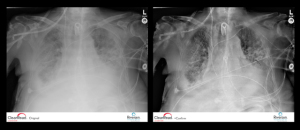by
Brendon Nafziger, DOTmed News Associate Editor | January 14, 2013

Left image is unenhanced,
right uses ClearRead + Confirm
(Credit: Riverain)
The Food and Drug Administration has cleared new Riverain Technologies software that helps make tubes and wires more visible in portable chest X-rays to reduce radiologist reading times, the company announced last week.
The software, called ClearRead + Confirm, scrubs out noise from portable X-rays and suppresses obstructive bone features to make catheter lines, feeding tubes and heart electrode wires easier to see by the interpreting radiologist to verify correct placement.
The program is based on technology previously developed by the company for noise elimination and digitally removing bones from images.



Ad Statistics
Times Displayed: 365169
Times Visited: 6993 Quality remanufactured Certified Centrifuges at Great prices! Fully warranted and backed by a company you can trust! Call or click for a free quote today! www.Centrifugestore.com 800-457-7576
"Through this image processing, we're able to significantly speed up the reading performance, because there is no longer the need to manipulate the image (to see the lines)," Steve Worrell, CEO of the Dayton, Ohio-based company, told DOTmed News.
Worrell said two main problems can make it hard for radiologists to detect tubes or lines in portable X-ray images. For one, bones like the ribs can mask the objects. Another is that portable X-ray images can be noisy, either because the patient is obese, and thus the X-rays have poor penetration, or they're lying down on a bed during the exam and their posture or positioning distorts the image. These noisy images can have a salt-and-pepper effect that makes them hard to read, he said.
Typically, to adjust for the noise or bone masking, radiologists have to pan and zoom on different areas or do window leveling, a technique to enhance contrast, which adds time to the task.
The company said in a reader study conducted at Georgetown University that was included in its FDA submission, 10 radiologists interpreted 334 portable chest X-ray images both with and without the enhancement software. Each radiologist was timed on how long it took to locate and mark the endpoint of lines and tubes in each version of the image (the order in which images were seen was randomized to prevent bias). Reading time using ClearRead + Confirm was shortened by about 19 percent, Riverain said.
The software, which received FDA clearance about a week ago, was cleared for sale in Europe in November, Worrell said.

